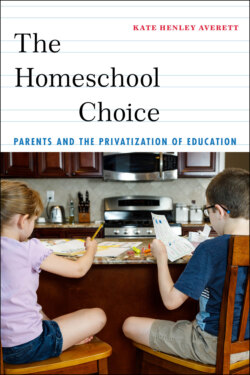Читать книгу The Homeschool Choice - Kate Henley Averett - Страница 36
Conclusion: Are Children “Born This Way”?
ОглавлениеThe parents whose voices are featured in this chapter share a sense that there are aspects of the public-schooling model that are fundamentally incompatible with what they believe childhood should look like. However, as demonstrated, the substance of their critiques is very different: for some of these parents, schools are overly sexual spaces, while for others, they are constraining or limiting to children’s education and identity development.
I argue that the reason some parents see schools as too sexual while others see schools as sexually limiting stems from the fact that these parents hold different ideologies of childhood gender and sexuality. On the one side, some parents want to limit their children’s knowledge and behaviors in order to create a strong and upright “character.” They want to limit these because they understand children as fundamentally innocent, as different from adults, and as having a malleable gender and sexuality that can be easily influenced in the “wrong” direction. On the other side, some parents want to expand children’s options for knowledge and behavior so as to protect their core sense of self. They want to expand these because they see children as fully human and, like adults, capable of exercising agency, and as having an innate gender and sexual identity that can be damaged by the constraints of public education.
In other words, there is not agreement among homeschooling parents about what childhood is, and there are important implications for the children of these parents of these differing beliefs about childhood. In her recent book Growing Up Queer: Kids and the Remaking of LGBTQ Identity, sociologist Mary Robertson uses feminist scholar Sara Ahmed’s concept of a “queer orientation” to capture the way in which sexual and gender identities—“the possibilities of straightness and queerness”—are shaped by our social worlds, through our interactions with others and through what we imagine to be possible.17 Ahmed argues in Queer Phenomenology that when we are children, our families play an important role in orienting us toward—and away from—certain possibilities. “Spatial orientations (relations of proximity and distance),” she argues, “are shaped by other social orientations, such as gender and class, that affect ‘what’ comes into view, but also are not simply given, as they are effects of the repetition of actions over time.”18 In Ahmed’s analysis, the repetition of compulsory heterosexuality19 within the family acts as a “straightening device,” one that literally produces straight orientations.
But might different family experiences orient children differently toward ideas about gender and sexuality? I argue that the case of homeschoolers, as detailed in this chapter, indicates that this is certainly the case. In this chapter, I have demonstrated that parents’ different understandings of childhood lead them to orient themselves differently in relation to their children, and orient their children differently vis-à-vis their own expressions of identity and desire, with different sets of repeated actions taken to shape—or not—their children’s behavior. The parents who participated in my study are thus likely raising children with very different orientations toward gender and sexuality, such that not only their present experiences but the realm of possible gendered and sexual futures for these children will be more or less constrained, depending on the view of childhood their parents take. And while the particular case of homeschoolers offers an unusually clear window into this phenomenon, because parents who homeschool are so accustomed to having to account for the unusual decisions that they make about their children’s education, all children are oriented by the institutions with which they interact, and thus are oriented by the ideologies of childhood that shape these institutions.
